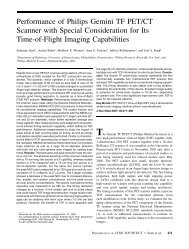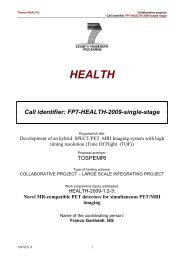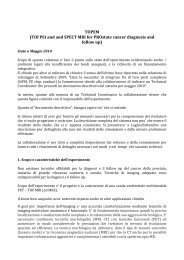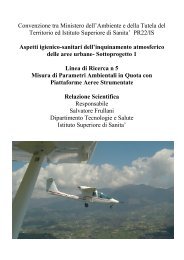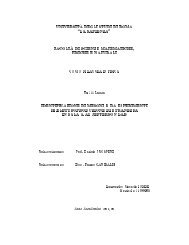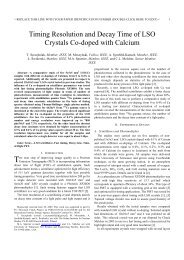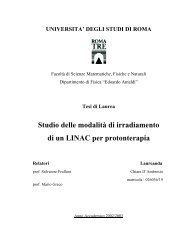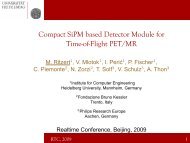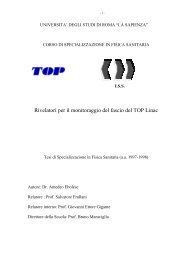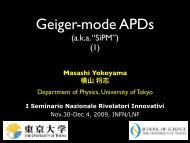First results in the application of Silicon Photomultiplier matrices to ...
First results in the application of Silicon Photomultiplier matrices to ...
First results in the application of Silicon Photomultiplier matrices to ...
Create successful ePaper yourself
Turn your PDF publications into a flip-book with our unique Google optimized e-Paper software.
<strong>First</strong> <strong>results</strong> <strong>in</strong> <strong>the</strong> <strong>application</strong> <strong>of</strong> <strong>Silicon</strong><br />
<strong>Pho<strong>to</strong>multiplier</strong> <strong>matrices</strong> <strong>to</strong> small<br />
animal PET<br />
G. Llosá, N. Belcari, M. G. Bisogni, G. Collazuol, A. del Guerra, S.<br />
Marcatili<br />
University <strong>of</strong> Pisa -INFN Pisa, Italy.<br />
M. Boscard<strong>in</strong>, M. Melchiorri, A. Tarolli, C. Piemonte, N. Zorzi<br />
FBK-irst, Tren<strong>to</strong>, Italy.<br />
P. Barrillon, S. Bondil-Bl<strong>in</strong>, V. Chaumat, C. de la Taille, N. D<strong>in</strong>u,<br />
V. Puill, J-F Vagnucci<br />
Labora<strong>to</strong>ire de l'Accélérateur L<strong>in</strong>éaire, IN2P3-CNRS, Orsay, France.<br />
This work is partially supported by <strong>the</strong> European Commision's Sixth<br />
Framework Program through a Marie Curie Intra-European Fellowship<br />
gabriela.llosa@pi.<strong>in</strong>fn.it NDIP08 Aix les Ba<strong>in</strong>s 15-20 June 2008 1
High resolution small animal PET<br />
! A high resolution small animal PET scanner with <strong>Silicon</strong><br />
<strong>Pho<strong>to</strong>multiplier</strong>s as pho<strong>to</strong>detec<strong>to</strong>rs is under development at <strong>the</strong><br />
University <strong>of</strong> Pisa.<br />
! <strong>Silicon</strong> pho<strong>to</strong>multiplier <strong>matrices</strong> from <strong>the</strong> Center from Scientific<br />
and technological research (FBK-irst , Tren<strong>to</strong>, Italy) will be<br />
employed.<br />
! The use <strong>of</strong> SiPM <strong>matrices</strong> has significant advantages <strong>in</strong> <strong>the</strong><br />
design <strong>of</strong> a detec<strong>to</strong>r head for a small animal PET <strong>to</strong>mograph wrt<br />
arrays <strong>of</strong> s<strong>in</strong>gle SiPMs:<br />
High pho<strong>to</strong>detec<strong>to</strong>r sensitivity: SiPM <strong>matrices</strong> leave low dead area<br />
wrt arrays <strong>of</strong> s<strong>in</strong>gle SiPMs.<br />
Small pitch: high spatial resolution.<br />
Ma<strong>in</strong> drawback: high number <strong>of</strong> output channels<br />
gabriela.llosa@pi.<strong>in</strong>fn.it NDIP08 Aix les Ba<strong>in</strong>s 15-20 June 2008 2
PET detec<strong>to</strong>r head<br />
! Use <strong>of</strong> cont<strong>in</strong>uous sc<strong>in</strong>tilla<strong>to</strong>r slabs + f<strong>in</strong>ely pixellated SiPM<br />
matrix can provide better performance than pixellated sc<strong>in</strong>tilla<strong>to</strong>r<br />
blocks:<br />
- Very good spatial resolution with maximum likelihood<br />
algorithms.<br />
- high efficiency : no light losses due <strong>to</strong> small pixel size.<br />
- lower cost.<br />
• Stack <strong>of</strong> several detec<strong>to</strong>r layers:<br />
– Discrete DOI <strong>in</strong>formation that reduces<br />
parallax error => higher spatial<br />
resolution.<br />
– High efficiency: <strong>in</strong>creased sc<strong>in</strong>tilla<strong>to</strong>r<br />
thickness.<br />
gabriela.llosa@pi.<strong>in</strong>fn.it NDIP08 Aix les Ba<strong>in</strong>s 15-20 June 2008 3
Detec<strong>to</strong>r head performance<br />
• Optimized geometry and performance estimated with GEANT4<br />
simulations.<br />
• Head geometry: stack <strong>of</strong> three detec<strong>to</strong>r layers (4 cm x 4 cm x 5 mm).<br />
– Cont<strong>in</strong>uous slab <strong>of</strong> LYSO, 5 mm thick=>15 mm <strong>to</strong>tal thickness.<br />
– SiPM matrix with 1.5 mm pitch elements as pho<strong>to</strong>detec<strong>to</strong>r.<br />
• Head performance:<br />
– About 70% efficiency for 511 keV pho<strong>to</strong>ns.<br />
– Intr<strong>in</strong>sic spatial resolution – 0.3 mm <strong>in</strong> <strong>the</strong> center <strong>of</strong> <strong>the</strong> crystal;<br />
< 1mm <strong>in</strong> <strong>the</strong> edges.<br />
• Center-<strong>of</strong>-gravity position determ<strong>in</strong>ation algorithms worsen resolution and<br />
displacement errors <strong>to</strong>wards <strong>the</strong> edges.<br />
• ML methods (skeweness and barycenter based) reduce error <strong>to</strong>wards <strong>the</strong><br />
edges.<br />
S. Moehrs et al. A detec<strong>to</strong>r head design for small-animal PET with silicon pho<strong>to</strong>multipliers (SiPM).<br />
Phys. Med. Biol. 51 (2006) 1113-1127.<br />
gabriela.llosa@pi.<strong>in</strong>fn.it NDIP08 Aix les Ba<strong>in</strong>s 15-20 June 2008 4
PET <strong>application</strong>s: rotat<strong>in</strong>g <strong>to</strong>mograph<br />
4-head <strong>to</strong>mograph (same concept as YAP(S)-PET):<br />
– 2(4) rotat<strong>in</strong>g detec<strong>to</strong>r heads at 10-15 cm distance.<br />
– FOV 4 cm axial, 4 cm transaxial.<br />
– efficiency around 4%<br />
– Spatial resolution better than 1 mm 3 for a po<strong>in</strong>t source <strong>in</strong> <strong>the</strong> CFOV.<br />
– low cost.<br />
gabriela.llosa@pi.<strong>in</strong>fn.it NDIP08 Aix les Ba<strong>in</strong>s 15-20 June 2008 5
MR compatible r<strong>in</strong>g <strong>to</strong>mograph<br />
• R<strong>in</strong>g <strong>to</strong>mograph <strong>to</strong> be <strong>in</strong>serted <strong>in</strong> a<br />
magnet bore <strong>of</strong> an MR system.<br />
• 16 detec<strong>to</strong>r heads, 7 cm x 2.4 cm;<br />
• FOV axial 7 cm, transaxial FOV ~6 cm.<br />
• Spatial resolution: 0.76 mm 3 for a 18 F po<strong>in</strong>t source<br />
<strong>in</strong> <strong>the</strong> CFOV with FBP.<br />
• efficiency around 11% for 250 keV energy<br />
threshold.<br />
Tests with SiPMs <strong>in</strong> MR system show no degradation <strong>of</strong> <strong>the</strong> data<br />
gradients <strong>of</strong>f<br />
gradients on<br />
gradients <strong>of</strong>f<br />
gradients on<br />
gabriela.llosa@pi.<strong>in</strong>fn.it NDIP08 Aix les Ba<strong>in</strong>s 15-20 June 2008 6
SiPM <strong>matrices</strong> from FBK-irst<br />
Composed <strong>of</strong> 16 pixel elements <strong>in</strong> a common substrate<br />
1 mm pixels <strong>in</strong> 1.06 mm pitch<br />
• Structure: n + -p-! -p + optimized for blue light:<br />
Shallow n + layer + specific antireflective coat<strong>in</strong>g.<br />
• 625 (25 x 25) microcells, 40 "m x 40 "m size.<br />
• Polysilicon quench<strong>in</strong>g resistance.<br />
• Fill fac<strong>to</strong>r (GF) 30 – 35%.<br />
• PDE 8 % at #V=3.5V for $ = 420 nm.<br />
4 mm<br />
1 mm<br />
gabriela.llosa@pi.<strong>in</strong>fn.it NDIP08 Aix les Ba<strong>in</strong>s 15-20 June 2008 7
<strong>First</strong> <strong>results</strong><br />
• Data acquisition system<br />
• Characterization<br />
• Measurements with pixellated crystals.<br />
• Measurements with cont<strong>in</strong>uous crystals.<br />
gabriela.llosa@pi.<strong>in</strong>fn.it NDIP08 Aix les Ba<strong>in</strong>s 15-20 June 2008 8
Readout: MAROC2 (LAL Orsay)<br />
• 64 channels (only 16 used)<br />
• Variable ga<strong>in</strong> (6 bits), low noise preamplifier<br />
• Slow shaper (~20-150 ns, adjustable)<br />
• Fast shaper (15 ns) + 3 discrim<strong>in</strong>a<strong>to</strong>rs=> trigger signal<br />
• Designed for MAPMT – not optimized for SiPMs, but<br />
allows us <strong>to</strong> make <strong>the</strong> first tests satisfac<strong>to</strong>rily.<br />
gabriela.llosa@pi.<strong>in</strong>fn.it NDIP08 Aix les Ba<strong>in</strong>s 15-20 June 2008 9
Readout: Test board<br />
• Altera FPGA<br />
• USB Port<br />
• ADC<br />
• ASIC calibration <strong>in</strong>put.<br />
• LabVIEW s<strong>of</strong>tware for<br />
data acquisition<br />
gabriela.llosa@pi.<strong>in</strong>fn.it NDIP08 Aix les Ba<strong>in</strong>s 15-20 June 2008 10
MAROC2 calibration<br />
• Calibration at m<strong>in</strong>imum preamplifier ga<strong>in</strong>: two l<strong>in</strong>ear ranges<br />
before saturation.<br />
• Good uniformity: % = 0.9 % at 7 pC; % = 1.5 % at 94 pC;<br />
• SiPM signals with pixellated crystals at high overvoltage (>2V)<br />
saturate <strong>the</strong> amplifier.<br />
gabriela.llosa@pi.<strong>in</strong>fn.it NDIP08 Aix les Ba<strong>in</strong>s 15-20 June 2008 11
Characterization<br />
• Very good uniformity<br />
• Breakdown voltage variations %= 0.3%<br />
gabriela.llosa@pi.<strong>in</strong>fn.it NDIP08 Aix les Ba<strong>in</strong>s 15-20 June 2008 12
Results with pixellated crystals<br />
Holder for precise position<strong>in</strong>g:<br />
Error < 50 "m.<br />
LYSO crystal array: 16 (4x4)<br />
crystals <strong>of</strong> 0.96 mm x 0.96 mm<br />
x 10 mm separated by 100 "m<br />
<strong>of</strong> white epoxy res<strong>in</strong>.<br />
Perfect match <strong>to</strong> <strong>the</strong> SiPM matrix<br />
gabriela.llosa@pi.<strong>in</strong>fn.it NDIP08 Aix les Ba<strong>in</strong>s 15-20 June 2008 13
Results with pixellated crystals<br />
NO COINCIDENCE<br />
BACKGROUND<br />
DUE TO 176 Lu<br />
– One SiPM pixel <strong>in</strong> <strong>the</strong> matrix<br />
– Na-22 energy spectra<br />
acquired with <strong>the</strong><br />
oscilloscope (no amplifier)<br />
– 3V overvoltage.<br />
COINCIDENCE WITH<br />
PMT + YAP crystal<br />
gabriela.llosa@pi.<strong>in</strong>fn.it NDIP08 Aix les Ba<strong>in</strong>s 15-20 June 2008 14
Results with pixellated crystals<br />
• Na-22 spectra from all channels with MAROC2 board<br />
• Co<strong>in</strong>cidence with 1x1x10 mm LSO crystal + s<strong>in</strong>gle SiPM<br />
• Peak position variation %=4.4%<br />
2 V overvoltage<br />
peak position variation Na spectrum all channels<br />
gabriela.llosa@pi.<strong>in</strong>fn.it NDIP08 Aix les Ba<strong>in</strong>s 15-20 June 2008 15
Results with cont<strong>in</strong>uous crystals<br />
• Crystal 4 mm x 4 mm x 5 mm cover<strong>in</strong>g<br />
<strong>the</strong> whole matrix.<br />
• Na-22 spectrum summ<strong>in</strong>g signals from<br />
all channels.<br />
4 V overvoltage<br />
gabriela.llosa@pi.<strong>in</strong>fn.it NDIP08 Aix les Ba<strong>in</strong>s 15-20 June 2008 16<br />
4 mm<br />
4 mm
Position determ<strong>in</strong>ation<br />
~35 mm 5 mm<br />
• Co<strong>in</strong>cidence with a 2 nd detec<strong>to</strong>r: 1 mm x 1 mm x<br />
1 mm crystal coupled <strong>to</strong> a SiPM<br />
• Source close <strong>to</strong> <strong>the</strong> matrix, far from 2 nd detec<strong>to</strong>r<br />
• Move <strong>to</strong>ge<strong>the</strong>r source and 2 nd detec<strong>to</strong>r <strong>in</strong> 0.5 mm<br />
steps.<br />
gabriela.llosa@pi.<strong>in</strong>fn.it NDIP08 Aix les Ba<strong>in</strong>s 15-20 June 2008 17
Position determ<strong>in</strong>ation<br />
Hitmap for different source position with crystal array<br />
+ 1 mm + 2 mm<br />
+ 0.5 mm + 1.5 mm<br />
gabriela.llosa@pi.<strong>in</strong>fn.it NDIP08 Aix les Ba<strong>in</strong>s 15-20 June 2008 18
Future work<br />
• Position determ<strong>in</strong>ation with cont<strong>in</strong>uous<br />
crystal<br />
• Tim<strong>in</strong>g measurements<br />
• <strong>First</strong> test pro<strong>to</strong>type<br />
– 2 rotat<strong>in</strong>g heads<br />
– Pixellated crystals<br />
– New readout system<br />
• Matrices 64 pixels will soon be fabricated.<br />
gabriela.llosa@pi.<strong>in</strong>fn.it NDIP08 Aix les Ba<strong>in</strong>s 15-20 June 2008 19
Conclusions<br />
• FBK-irst has developed SiPM <strong>matrices</strong> with 16 SiPM pixels<br />
<strong>in</strong> a common substrate. The first <strong>results</strong> obta<strong>in</strong>ed are very<br />
good and lead <strong>to</strong> <strong>the</strong> fabrication <strong>of</strong> SiPM <strong>matrices</strong> with 64<br />
pixels.<br />
•A very high resolution PET <strong>to</strong>mograph for small animals<br />
employ<strong>in</strong>g SiPMs as pho<strong>to</strong>detec<strong>to</strong>rs is under development<br />
at <strong>the</strong> University <strong>of</strong> Pisa. A spatial resolution <strong>of</strong> 0.76 mm<br />
FWHM is expected for a 18 F po<strong>in</strong>t source <strong>in</strong> water <strong>in</strong> <strong>the</strong><br />
centre <strong>of</strong> <strong>the</strong> FOV, employ<strong>in</strong>g FBP for image reconstruction,<br />
accord<strong>in</strong>g <strong>to</strong> GEANT4 simulations.<br />
• The first tests <strong>to</strong>wards <strong>the</strong> PET scanner construction are<br />
ongo<strong>in</strong>g with good <strong>results</strong>. Tests with both pixellated and<br />
cont<strong>in</strong>uous crystals are be<strong>in</strong>g carried on.<br />
• A first pro<strong>to</strong>type with two rotat<strong>in</strong>g heads is be<strong>in</strong>g<br />
assembled, employ<strong>in</strong>g pixellated crystals.<br />
gabriela.llosa@pi.<strong>in</strong>fn.it NDIP08 Aix les Ba<strong>in</strong>s 15-20 June 2008 20
<strong>Silicon</strong> <strong>Pho<strong>to</strong>multiplier</strong>s<br />
SiPM : Multicell Avalanche Pho<strong>to</strong>diode work<strong>in</strong>g <strong>in</strong> limited Geiger mode<br />
- 2D array <strong>of</strong> microcells: structures <strong>in</strong> a common bulk.<br />
-Vbias > Vbreakdown: high field <strong>in</strong> mult. region.<br />
- Microcells work <strong>in</strong> Geiger mode: <strong>the</strong> signal is <strong>in</strong>dependent <strong>of</strong> <strong>the</strong> particle energy<br />
- The SiPM output is <strong>the</strong> sum <strong>of</strong> <strong>the</strong> signals produced <strong>in</strong> all microcells fired.<br />
! Significant advantages wrt o<strong>the</strong>r pho<strong>to</strong>detec<strong>to</strong>rs:<br />
• High Ga<strong>in</strong><br />
• Fast tim<strong>in</strong>g<br />
• High PDE<br />
• High S/N ratio<br />
• Insensitive <strong>to</strong> magnetic fields<br />
• Low operat<strong>in</strong>g voltage<br />
• Potential low cost<br />
n + cathode +VGM h&<br />
p high-electric field<br />
multiplication region<br />
! epilayer<br />
p + substrate<br />
gabriela.llosa@pi.<strong>in</strong>fn.it NDIP08 Aix les Ba<strong>in</strong>s 15-20 June 2008 21<br />
4 µm<br />
oxide<br />
e -<br />
hole
New detec<strong>to</strong>rs<br />
• Different geometry, size, microcell size and GF.<br />
40x40!m => GF 44%<br />
50x50!m => GF 50%<br />
100x100!m => GF 76%<br />
• Matrices 16 elements (4x4)<br />
4 mm<br />
4 mm<br />
IV CURVES OF 9<br />
MATRICES. VERY<br />
UNIFORM<br />
BREAKDOWN<br />
POINT<br />
N41-2: C. Piemonte. Recent Progress <strong>in</strong> <strong>the</strong><br />
Performance <strong>of</strong> <strong>Silicon</strong> <strong>Pho<strong>to</strong>multiplier</strong>s<br />
produced at FBK-irst.<br />
circular (1mm diam) 1x1mm 2x2mm 3x3mm (3600 cells) 4x4mm (6400 cells)<br />
gabriela.llosa@pi.<strong>in</strong>fn.it NDIP08 Aix les Ba<strong>in</strong>s 15-20 June 2008 22


